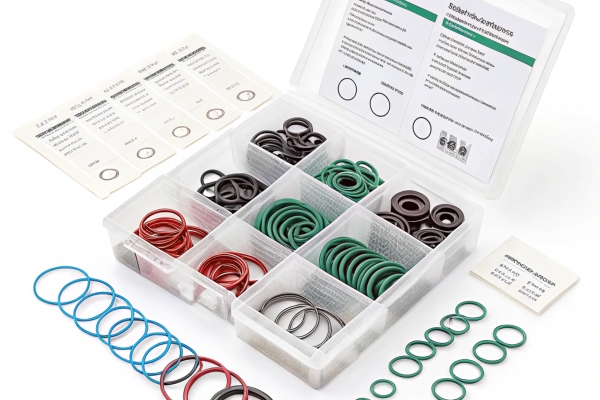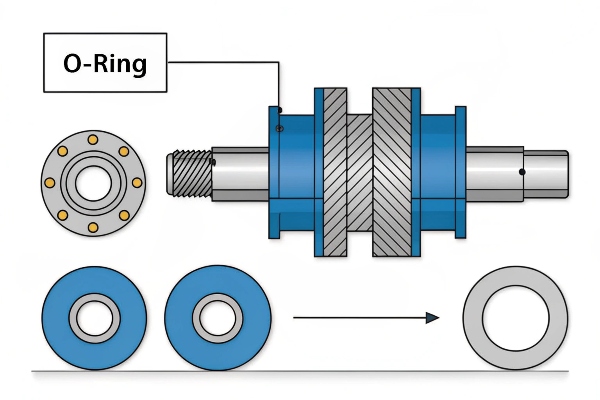O-rings are essential components in various mechanical systems, offering a simple yet effective solution for sealing applications. But what exactly are they used for, and why are they so widely used across industries?
O-rings are used to seal joints and prevent leakage of fluids or gases in various applications. Their design makes them a reliable sealing solution for many industries.

To fully appreciate their utility, let's explore the definition, working principle, and advantages of O-rings, and understand their importance in industries.
What is the definition of an O-ring?
The O-ring is a simple but vital component used to create a seal. But what exactly defines an O-ring, and why is it so indispensable in so many applications?
An O-ring is a round, doughnut-shaped sealing device that fits into a groove and is compressed to prevent the leakage of fluids or gases.
Definition of an O-ring
An O-ring is a circular elastomeric sealing device used to create a seal between two or more parts. The O-ring is typically made from a variety of rubber materials, including nitrile, silicone, or fluorocarbon, depending on the application. It is placed in a groove and then compressed between two mating surfaces to prevent the leakage of liquids or gases. O-rings are used in a wide range of industries, including automotive, aerospace, and manufacturing, where fluid containment or pressure regulation is necessary.
| Material | Common Applications |
|---|---|
| Nitrile | Automotive, oil & gas, hydraulic systems |
| Silicone | Food processing, medical equipment |
| Fluorocarbon | Chemical, aerospace, high-temperature environments |
What is the principle of an O-ring?
How does an O-ring function to seal joints effectively? Understanding its basic principles can help in selecting the right O-ring for specific applications.
The O-ring works by being compressed between two surfaces, creating a seal that prevents the leakage of fluids or gases. This compression is key to its performance.
Principle of an O-ring
The basic principle behind an O-ring’s functionality is simple but highly effective. When the O-ring is placed in a groove between two mating parts, it gets compressed as the parts are joined. This compression causes the O-ring to deform slightly, filling any gaps and creating a tight seal. The sealing action prevents the escape of fluids or gases, even under pressure. The material used for the O-ring plays a critical role in its ability to withstand different conditions, such as temperature extremes, chemical exposure, or pressure.
Compression is the key factor that determines the sealing efficiency. If the O-ring is compressed too much, it may fail, but if not compressed enough, the seal won't form properly.
| O-ring Material | Sealing Temperature Range | Typical Applications |
|---|---|---|
| Nitrile | -40°C to 120°C | Hydraulic, automotive |
| Silicone | -55°C to 230°C | Aerospace, food & beverage |
| Fluorocarbon | -20°C to 250°C | Chemical, pharmaceutical |
Where is the O-ring located?
O-rings are used in various systems to ensure leak-proof seals. But where exactly are they typically found in mechanical assemblies?
O-rings are typically found in joints or connections between two parts in machinery or systems, such as pumps, valves, and engines, where they seal gaps between surfaces.
O-ring Locations in Machinery
O-rings are commonly located in mechanical assemblies where two parts are joined and require a reliable seal. Some typical locations include:
- Pumps and Valves: O-rings are often used to seal the connections between the pump housing and the valve, preventing fluid leakage.
- Engines: O-rings are used in automotive engines to seal cylinder heads, fuel injectors, and other components.
- Hydraulic Systems: O-rings are placed at the junctions of hydraulic cylinders and actuators to prevent the loss of hydraulic fluid.
- Compressors: O-rings are commonly used in compressors to seal gas or air leaks.
| Application | O-ring Location | Purpose |
|---|---|---|
| Automotive | Engine seals, fuel injectors | Prevent leakage of fluids |
| Aerospace | Aircraft hydraulics | Seal connections under pressure |
| Industrial Pumps | Pump housings | Ensure leak-proof operation |
What is the maximum pressure for an O-ring?
When it comes to O-rings, one of the most important factors to consider is their ability to withstand pressure. But what is the maximum pressure an O-ring can handle?
The maximum pressure for an O-ring depends on factors like material, size, and sealing configuration. Generally, O-rings can handle pressures up to several thousand psi in specialized applications.
Maximum Pressure for O-rings
O-rings are designed to handle a variety of pressures, but their specific maximum pressure depends on several key factors:
- Material Type: Different O-ring materials can withstand varying pressure levels. For example, elastomers like nitrile or fluoroelastomers can handle higher pressures than silicone or EPDM.
- Size and Groove Design: The size of the O-ring and the design of the groove it sits in can influence how much pressure it can handle. A properly sized O-ring with an adequate groove design will seal better under pressure.
- Temperature: High temperatures can reduce the sealing performance of O-rings, making them more susceptible to pressure leaks. The combination of pressure and temperature will determine the performance limits.
- Application Type: Dynamic seals (such as those used in pumps or pistons) typically face lower pressures than static seals, which are often used in high-pressure applications.
O-rings in industrial applications can typically withstand pressures up to 5,000 psi (345 bar) in the right conditions. However, custom materials and configurations may enable them to handle even higher pressures, especially in high-performance industries like aerospace or automotive.
| O-ring Material | Max Pressure Range (psi) | Typical Applications |
|---|---|---|
| Nitrile (Buna-N) | 1,000 - 3,000 | Automotive, hydraulic systems |
| Fluorocarbon (Viton) | 2,000 - 4,000 | Chemical, aerospace applications |
| Silicone | 500 - 1,500 | Food processing, medical devices |
| EPDM | 1,000 - 2,000 | Automotive, water and HVAC systems |
Factors Affecting O-ring Pressure Resistance
Several factors can influence an O-ring’s ability to withstand pressure:
- Compression Set: If an O-ring is compressed too much, it can lose its elasticity and sealing capability, making it more prone to failure under pressure.
- Material Hardness: Harder materials generally handle higher pressures, but may be less flexible, which could be a concern in dynamic applications.
- Environmental Conditions: Exposure to chemicals, UV light, or extreme temperatures can weaken an O-ring over time, lowering its pressure resistance.
How to Increase O-ring Pressure Resistance
- Material Selection: Choose O-rings made from materials with higher resistance to pressure, such as Viton or fluorocarbon.
- Proper Sizing: Ensure the O-ring is sized correctly for the groove, as too much compression or insufficient compression can lead to failure under pressure.
- Use Back-Up Rings: For high-pressure applications, using backup rings alongside the O-ring can help distribute pressure more evenly, improving the seal's durability.
| Pressure Factor | Impact on O-ring Performance |
|---|---|
| Compression Set | Reduces sealing efficiency |
| Material Hardness | Affects flexibility and pressure resistance |
| Environmental Exposure | Decreases long-term pressure handling ability |
The maximum pressure an O-ring can handle depends on various factors, including the material, size, and specific application. While standard O-rings can handle pressures up to 5,000 psi, selecting the right material and configuration for your specific needs will ensure reliable sealing under high-pressure conditions.
What are the advantages of the O-ring?
O-rings provide a wide range of benefits in sealing applications. So, what makes them so widely preferred in many industries?
O-rings are cost-effective, reliable, and versatile sealing solutions that can withstand harsh environments, making them a popular choice for many industries.
Advantages of Using O-rings
O-rings have many advantages that make them the go-to sealing solution in various industries:
- Cost-Effective: O-rings are generally inexpensive to manufacture, making them a cost-effective sealing solution.
- Easy to Install: They are simple to install, requiring minimal tools and labor.
- Versatility: O-rings can be used in many different types of applications, including both static and dynamic seals.
- Reliable Performance: O-rings provide a dependable seal, even under high pressure, temperature, or chemical exposure.
Despite their many benefits, O-rings do have limitations in certain environments where more specialized sealing solutions are required.
| Advantage | Explanation |
|---|---|
| Cost-Effective | Low production costs for a reliable seal |
| Easy to Install | Quick and straightforward installation |
| Versatility | Suitable for a wide range of applications |
| Reliable Performance | Effective sealing in extreme conditions |
How to inspect an O-ring?
Regular inspection of O-rings is crucial to ensure they continue to function effectively. What steps should be taken to inspect an O-ring?
Inspecting O-rings involves checking for wear, cracks, or deformation that may compromise their sealing ability, ensuring continued performance.
Inspecting an O-ring
Inspecting an O-ring is a critical step in maintaining system integrity. To inspect an O-ring, look for the following:
- Visual Inspection: Check for any cracks, cuts, or deformation in the O-ring. Even slight damage can impact its sealing effectiveness.
- Compression Test1: Ensure the O-ring is still compressing effectively between the mating parts. If the compression is insufficient, the seal may fail.
- Surface Integrity2: The O-ring should be smooth and free from abrasions or wear marks that could cause leaks.
- Material Degradation: Over time, O-rings can degrade due to exposure to extreme temperatures or chemicals. Ensure that the material is still suitable for the operating conditions.
| Inspection Step | Action |
|---|---|
| Visual Inspection | Look for cracks, cuts, or wear |
| Compression Test | Check if the O-ring still compresses properly |
| Surface Integrity | Ensure smooth, undamaged surfaces |
| Material Degradation | Examine for signs of material breakdown |
How do I choose an O-ring?
Choosing the right O-ring for a specific application is crucial for optimal performance. What factors should you consider when selecting an O-ring?
To choose the right O-ring, consider material compatibility, size, pressure, temperature, and environmental factors such as exposure to chemicals.
Choosing the Right O-ring
When selecting an O-ring, it’s important to keep the following factors in mind:
- Material Compatibility3: Choose a material that can withstand the chemicals, temperature, and pressure in your application (e.g., nitrile for oil resistance, silicone for high-temperature applications).
- Size and Fit: Ensure the O-ring’s size matches the groove dimensions and that it is compressed enough to form a proper seal.
- Pressure and Temperature: Consider the pressure and temperature extremes the O-ring will face in operation.
- Chemical Exposure: Some O-ring materials are more resistant to certain chemicals, so it's important to know the exposure conditions.
| Selection Factor | Consideration |
|---|---|
| Material Compatibility | Choose based on chemical, pressure, and temperature needs |
| Size and Fit | Ensure proper groove dimensions and compression |
| Pressure and Temperature | Select based on operating conditions |
| Chemical Exposure | Choose based on the chemicals the O-ring will contact |
Conclusion
In conclusion, O-rings are indispensable sealing components in many industries due to their versatility, cost-effectiveness, and reliability. By understanding the principles, advantages, and key factors for selecting O-rings, you can ensure they perform optimally in your applications.
Footnotes:
Learning how to conduct a compression test can help you assess the O-ring's sealing effectiveness, ensuring system integrity and performance. ↩
Exploring the importance of surface integrity can help you understand how it affects sealing performance and leak prevention in applications. ↩
Understanding material compatibility is essential for ensuring the O-ring can withstand the specific chemicals and conditions it will face, preventing failures. ↩








